
 |
| |
||||||||||||||||
|
|||||||||||||||||||||||||||||||||||||||||||||||||||||||||
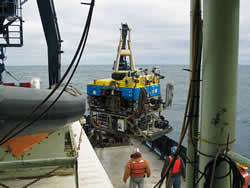 Crew of Atlantis and Jason, launching the ROV. (click image for larger view) |
This is my first time to the deep mid ocean ridge and what a spectacular and magnificent area to study. Hydrothermal circulation and the vents that exist here are critical to the survival of distinct and sensitive ecosystems. We would not be able to study these seafloor features if it wasn’t for the deep submergence technology that is available from the National Science Foundation and operated by the Woods Hole Oceanographic Institution. We are using the ROV Jason II to find a significant hydrothermal plume that we can monitor over the long term. The methodology is based on acoustic scintillation where we propagate sound over a 100 m path through the turbulent flow 20 m above the vent orifice allowing us to measure the vertically driven buoyant flow and temperature fluctuations.
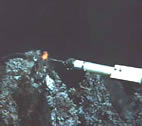 HOBO deployed at Dante. |
Our first task was to find a hydrothermal vent of interest. We first explored a vent named Grotto in the Main Endeavour field and although there were some black smokers we decided to have a look at nearby Dante vent for comparison. Once arriving at Dante it was clear that this was the plume to study. There was significant high temperature (330°C) venting and many plumes coalescing from nearby vent orifices. As the acoustic scintillation method gives path averaged measurements our approach is to obtain an integrated measurement of the vertical flow of the plume as it mixes with surrounding oceanic water. In addition, we deployed a high temperature probe directly in the vent which will record continuously for ~1 year.
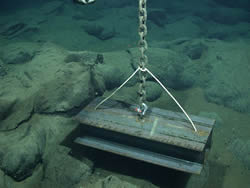 Positioning of the acoustic instrument anchor at its final location. (click image for larger view) |
Next, we deployed two mooring from the ship (one with a sound transmitter and the other with a receiver). Once on the bottom we located them with ROV Jason and then moved them into precise position 50 meters on either side from the vent plume. In this arrangement, the two moorings will transmit sound from one to the other directly through the hot-water plume above Dante vent. The moorings are now on the seafloor collecting data and we will return in September to recover the instruments, download the data they recorded, and then we will re-deploy them again until next spring or summer. Changes in the sound that passed through the plume will tell us information about the plume itself and how its output varies over time.
|
Sep/Oct 2004
| ||||||
| S | M | T | W | T | F | S |
| 12 | 13 | 14 | 15 | 16 | 17 | 18 |
| 19 | 20 | 21 | 23 | 24 | 25 | |
| 26 | 27 | 28 | 29 | 30 | 1 | 2 |
Today's Events:
Jason dive J2-286 at Endeavour
RAS recovered
|
Today's
photos |
|
click
caption for larger view |
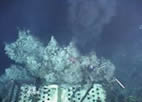 Hydrothermal plume over Dante vent. |
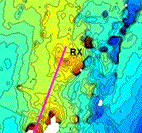 Map showing the location of the acoustic instruments. |
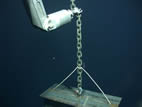 Jason moving the acoustic instrument anchor. Jason moving the acoustic instrument anchor. |
| NeMO Home |About NeMO | Expeditions | NeMO Net | Explore | Dive! | Education |